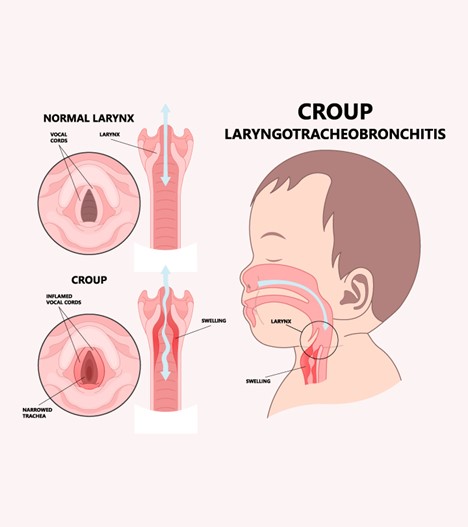What distinguishing manifestation of spasmodic croup should parents be taught to identify?
The child has a high fever.
It has a harsh, barky cough.
It is bacterial in nature.
Wheezing is heard audibly.
The Correct Answer is B
The correct answer is choice B. It has a harsh, barky cough.
Choice A rationale:
Spasmodic croup is characterized by sudden-onset symptoms, including a barking cough, but it is not typically associated with a high fever. The barky cough is caused by inflammation and narrowing of the upper airways, leading to a distinct sound when the child coughs.
Choice B rationale:
A harsh, barky cough is a hallmark symptom of spasmodic croup. It is caused by the swelling of the vocal cords and the upper airway, resulting in the characteristic sound. This type of croup is often triggered by viral infections and is usually not bacterial in nature.
Choice C rationale:
Spasmodic croup is usually of viral origin rather than bacterial. Bacterial infections may lead to other respiratory conditions, but they are not a distinguishing feature of spasmodic croup.

Choice D rationale:
Wheezing is not a typical manifestation of spasmodic croup. Wheezing is often associated with lower airway conditions such as asthma, while croup primarily affects the upper airways and vocal cords, leading to the barking cough.
Nursing Test Bank
Naxlex Comprehensive Predictor Exams
Related Questions
Correct Answer is D
Explanation
The correct answer is choice E. Board games.
Choice A rationale:
Computer games might not be the best choice for a child with osteomyelitis. These games involve prolonged screen time and limited physical movement, which could potentially hinder the child's recovery.
Choice B rationale:
Paper and paints involve a level of physical activity that might not be suitable for a child with osteomyelitis. The child's movement might be restricted due to the condition, and activities that require fine motor skills might not be comfortable for them.
Choice C rationale:
Jack-in-the-box involves sudden surprises and might startle the child, which could be detrimental to their recovery. Children with osteomyelitis might be dealing with pain and discomfort, so it's important to avoid activities that could cause unnecessary distress.
Choice D rationale:
Stuffed animals might be a comforting option for the child. However, the child might also experience pain or discomfort when handling stuffed animals due to their condition. It's better to choose activities that don't involve physical contact that could potentially exacerbate the child's symptoms.
Choice E rationale:
Board games are a suitable choice for a child with osteomyelitis. They provide mental stimulation and entertainment without requiring excessive physical activity. Board games also promote social interaction if played with others, which is important for the child's emotional well-being during their hospital stay.

Correct Answer is A
Explanation
The correct answer is choice A: Avoiding use for more than 3 days.
Choice A rationale:
Recommending avoiding the use of decongestant nose drops for more than 3 days is crucial due to the risk of rebound congestion. Decongestant nose drops work by constricting blood vessels in the nasal passages to alleviate congestion. Prolonged use can lead to a phenomenon known as rebound congestion, where the nasal passages become more congested once the medication wears off, causing the person to use the drops more frequently. This can result in a cycle of worsening congestion and overuse of the medication, which can be counterproductive and harmful. Limiting the use of decongestant nose drops to 3 days helps prevent this rebound effect and encourages the use of alternative treatments if congestion persists.
Choice B rationale:
Administering drops until nasal congestion subsides is not the recommended approach. Prolonged use of decongestant nose drops can lead to rebound congestion, as mentioned earlier. Using the drops until congestion subsides might extend their use beyond the safe period and increase the risk of adverse effects.
Choice C rationale:
Keeping drops to use again for nasal congestion is not advised. While it's important to follow the medication's storage instructions, relying on decongestant nose drops for recurring nasal congestion can lead to overuse and rebound congestion. This choice does not address the potential risks associated with prolonged use.
Choice D rationale:
Administering drops after feedings and at bedtime is not a standard recommendation for decongestant nose drops. The timing of administration is not a primary concern in the context of decongestant use. Instead, the focus should be on the duration of use and the potential for rebound congestion.
Whether you are a student looking to ace your exams or a practicing nurse seeking to enhance your expertise , our nursing education contents will empower you with the confidence and competence to make a difference in the lives of patients and become a respected leader in the healthcare field.
Visit Naxlex, invest in your future and unlock endless possibilities with our unparalleled nursing education contents today
Report Wrong Answer on the Current Question
Do you disagree with the answer? If yes, what is your expected answer? Explain.
Kindly be descriptive with the issue you are facing.
